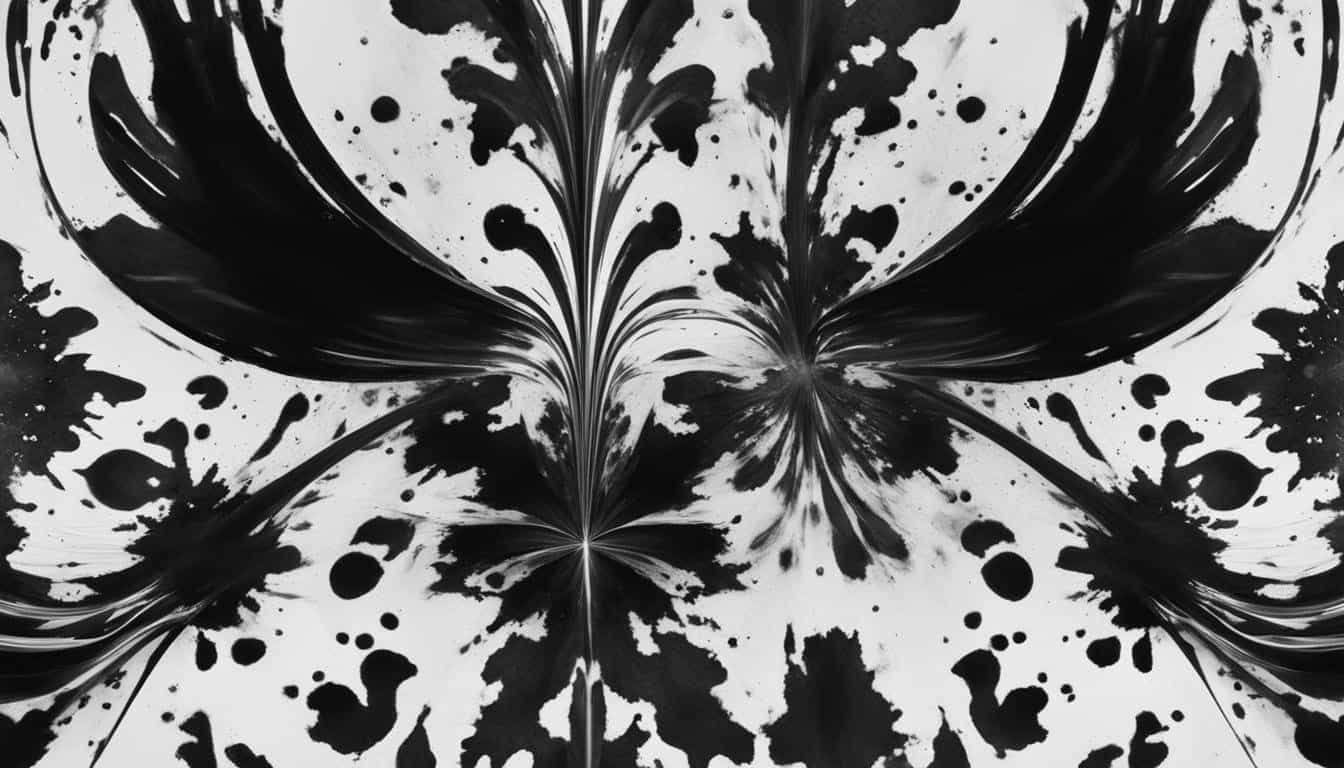Understanding the Rorschach Inkblot Test Insights
Welcome to the fascinating world of the Rorschach Inkblot Test! This psychological assessment, also known as a projective test, offers unique insights into the human mind. By exploring the interpretation of inkblot images, this test provides valuable information about personality traits, emotional functioning, and more.
The Rorschach Inkblot Test involves presenting individuals with a series of inkblot cards and asking them to describe what they see. This ambiguous task taps into their subconscious, unlocking hidden aspects of their psyche. It is widely used in psychotherapy, counseling, and clinical assessment settings to gather qualitative data and aid in the diagnostic process.
Throughout this article, we will delve into the history, administration, scoring, and interpretation of the Rorschach Inkblot Test. We will explore its uses as a diagnostic tool and its applications in various settings. Additionally, we will address the controversies and limitations associated with this test to provide you with a comprehensive understanding.
Key Takeaways:
- The Rorschach Inkblot Test is a projective assessment used to gather qualitative information about an individual’s personality and emotional functioning.
- The test involves interpreting 10 ambiguous inkblot images and analyzing factors such as content, location, and determinants.
- It can be used as a diagnostic tool in psychological evaluations and is also applied in organizational settings to assess attributes like creativity.
- Scoring and interpretation of the test require expertise and knowledge of personality dynamics.
- While the Rorschach Inkblot Test has faced criticisms, it remains a valuable tool in understanding the complexities of human psychology.
History of the Rorschach Inkblot Test
The Rorschach inkblot test, also known as a projective test, was developed by Swiss psychologist Hermann Rorschach in 1921. Inspired by his childhood game of creating inkblots and making up stories about them, Rorschach sought to explore the deeper workings of the human mind through this innovative psychological assessment.
During his time working in a psychiatric hospital, Rorschach noticed that patients with schizophrenia responded differently to the inkblots, which piqued his curiosity. This observation led him to develop a systematic approach using inkblots as a tool for evaluating cognition, personality traits, and diagnosing mental disorders.
To ensure consistency and standardization in the administration, scoring, and interpretation of the test, the Exner system was later introduced as the gold standard. This system provides a structured framework for clinicians to analyze factors such as content, location, and determinants in understanding individuals’ responses to the inkblots.
“The Rorschach inkblot test offers unique insights into the subconscious mind, providing a window into an individual’s thoughts and emotions. It has revolutionized the field of psychological assessment and continues to be used in various settings to this day.”
As the Rorschach inkblot test gained popularity, it opened new avenues for understanding complex psychological processes and exploring the depths of human perception. With its rich history and continued relevance, this projective test remains a valuable tool for clinicians and researchers alike.
How Does the Rorschach Inkblot Test Work?
The Rorschach inkblot test is a projective measure that aims to uncover unconscious thoughts and aspects of a person’s psyche. The test involves showing 10 inkblot images to the individual and asking them to describe what they see. There are no right or wrong answers, and the responses are recorded verbatim. The clinician then analyzes factors such as content, location, and determinants in interpreting the responses. The test relies on the individual’s subjective interpretation of the inkblots, providing insights into their social behavior, thoughts, and emotions.
Through the Rorschach inkblot test, individuals have the opportunity to project their inner thoughts and feelings onto the ambiguous images, offering a glimpse into the workings of their minds. The test taps into the unconscious aspects of the human psyche, revealing hidden aspects that might not be accessible through other methods of psychological assessment.
The subjective nature of the test allows individuals to express their unique perspectives and associations, providing valuable information about their cognitive processes, emotional experiences, and interpersonal dynamics. As they freely interpret the inkblots without any constraints, the Rorschach inkblot test guides clinicians in understanding the individual’s subjective responses and making interpretations based on their content, location, and determinants.
Revealing the Unconscious
The Rorschach inkblot test delves beyond the surface-level responses and taps into the deep recesses of the unconscious mind. It unveils the individual’s implicit thoughts, suppressed emotions, and innate personality traits. By analyzing the patterns, symbols, and themes that emerge in their interpretations, clinicians gain insights into the individual’s underlying motivations, conflicts, and psychological processes.
- Content: The content of the individual’s responses refers to the specific objects, figures, or features they perceive within the inkblots. It provides clues about their cognitive focus, interests, and how they perceive the world around them.
- Location: The location of the responses refers to the specific areas in the inkblots where the individual identifies their perceptions. It offers insights into their attentional processes, level of detail orientation, and cognitive organization.
- Determinants: The determinants of the responses refer to the factors influencing the individual’s interpretations, such as color, movement, or shading. They reflect the individual’s emotional experiences, mood, and underlying psychological dynamics.
By considering these factors in the interpretation of inkblot responses, the Rorschach inkblot test provides a comprehensive understanding of the individual’s psychological functioning, shedding light on their subconscious processes, and contributing to their overall assessment.
Scoring and Interpretation of the Rorschach Inkblot Test
Scoring the Rorschach inkblot test is a complex process that requires knowledge of personality dynamics and experience with the test. The test is scored using the Exner system, which includes factors such as content, location, and determinants.
The interpretation of the test is based not only on formal scores but also on behaviors expressed during the testing, patterns of scores, and unique perceptions. This comprehensive approach allows the clinician to gain a deeper understanding of the individual’s personality traits, emotional functioning, and thought processes.
The Rorschach inkblot test offers valuable insights into a person’s psychological makeup. By analyzing the content of their responses, the clinician can gain insights into the individual’s personality dynamics, such as their level of abstraction, ability to form relational thinking, and cognitive flexibility.
However, it is important to note that the test has limitations and should not be used as the sole diagnostic tool. It is most effective when used alongside other assessment measures and clinical observations.
Scoring and interpreting the Rorschach inkblot test requires a trained professional with a deep understanding of personality dynamics. As the test relies on the individual’s subjective responses, it is crucial to consider their unique perspectives and cognitive processes in order to gain a thorough understanding of their psychological profile.
Uses of the Rorschach Inkblot Test
The Rorschach inkblot test is a versatile and valuable tool utilized in various settings, including psychotherapy, counseling, schools, hospitals, and courtrooms. Its primary purpose is to conduct psychological evaluations and gain qualitative insights into individuals, assessing their personalities, emotional functioning, and thinking patterns. The results of the test serve as a foundation for further discussion and exploration of pertinent issues.
Organizations also employ the Rorschach inkblot test as a diagnostic tool for employment suitability and adoption approval. By assessing attributes such as creativity, intelligence, and temperament, employers can make informed decisions about potential candidates. Similarly, adoption agencies use the test to evaluate prospective adoptive parents, ensuring that the child’s needs and circumstances align with the parents’ capabilities.
Rorschach Inkblot Test in Psychotherapy
The Rorschach inkblot test provides a unique opportunity for therapists to delve deep into their clients’ thought processes, emotions, and experiences. By analyzing their interpretations of the inkblots, therapists can gain a richer understanding of their clients’ inner worlds, uncovering hidden traumas, conflicts, and strengths. It serves as a beneficial tool for exploring aspects of the unconscious mind that may not readily emerge through conventional means.
Rorschach Inkblot Test in Organizational Settings
In organizational settings, the Rorschach inkblot test serves as a valuable assessment tool for evaluating employment suitability. By examining an individual’s responses to the inkblots, employers can gain insights into their creativity, problem-solving abilities, and overall temperament. This information aids in making informed decisions when hiring for positions that require innovative thinking, adaptability, and emotional stability.
| Application | Benefits | Examples |
|---|---|---|
| Psychological Evaluation | Provides qualitative insights into an individual’s personality, emotional functioning, and thinking patterns. | Assessing an individual’s cognitive strengths and weaknesses for therapeutic intervention. |
| Employment Suitability | Evaluates attributes such as creativity, intelligence, and temperament for the selection of suitable candidates. | Assessing a candidate’s problem-solving skills and adaptability for a creative role in an advertising agency. |
| Adoption Approval | Assesses the suitability of potential adoptive parents and ensures a good match with the child’s needs. | Evaluating a couple’s ability to provide a stable and nurturing environment for a child. |
Controversies Surrounding the Rorschach Inkblot Test
The Rorschach inkblot test, while widely used, has not been immune to criticism regarding its reliability, validity, and diagnostic value. One of the main concerns raised is the inherent subjectivity in scoring the test, which heavily relies on examiner interpretation. This subjectivity can result in variations in results when different examiners score the same responses. As a result, the test’s reliability, or consistency of results, has been called into question.
Another area of contention revolves around the test’s validity, or its ability to measure what it claims to measure. Some skeptics argue that the Rorschach inkblot test may not accurately diagnose most psychological disorders, undermining its diagnostic value. However, it is important to note that the test has shown value in assessing thought disorders and symptoms related to schizophrenia. In fact, certain unique responses to the inkblots have been associated with specific symptoms of these disorders, providing some diagnostic utility in these cases.
In 1999, a group of psychologists even recommended a moratorium on the use of the Rorschach inkblot test until further research could better determine its true validity and address the concerns surrounding its reliability. Since then, ongoing studies have aimed to shed light on the test’s strengths and limitations, helping to inform its ongoing use within the field of psychological assessment.
How the Rorschach Inkblot Test Differs from Other Personality Tests
Unlike objective personality tests that use standardized methods and self-report questionnaires, the Rorschach inkblot test is a projective measure. It relies on the individual’s projection and subjective interpretation of ambiguous stimuli.
The test involves showing 10 inkblot images to the individual and asking them to describe what they see. There are no right or wrong answers, as the test aims to uncover unconscious thoughts and aspects of a person’s psyche.
By describing what they see in the inkblots, individuals provide insights into their personality and how they project meaning onto the world. This unique approach offers a window into their social behavior, thoughts, and emotions.
Unlike self-report questionnaires, which rely on the individual’s conscious awareness and willingness to disclose information, the Rorschach inkblot test delves into the subconscious realm, revealing aspects that individuals may not be aware of or may be hesitant to report.
“The Rorschach inkblot test offers a unique way to assess an individual’s thoughts and emotions without relying solely on self-reported data.”
This projective measure enables clinicians and psychologists to gain a deeper understanding of a person’s personality traits, emotional functioning, and thought processes, providing a more holistic view of their psychology.
While objective personality tests and self-report questionnaires have their merits, the Rorschach inkblot test offers a complementary approach that can reveal hidden insights and provide a richer understanding of an individual’s psychological makeup.
How the Rorschach Inkblot Test Differs:
- Relies on projection and subjective interpretation
- Uncovers unconscious thoughts and aspects of the psyche
- Offers a unique window into social behavior, thoughts, and emotions
- Goes beyond self-reported data
- Provides insights into personality traits, emotional functioning, and thought processes
Applications of the Rorschach Inkblot Test
While the use of the Rorschach Inkblot Test has declined in recent years, it still holds significance in specific scenarios. This projective assessment can assist in diagnosing schizophrenia as individuals with the disorder often exhibit unique responses to the inkblots. The Rorschach test can provide valuable insights into the cognitive and perceptual disturbances associated with schizophrenia.
Moreover, the Rorschach Inkblot Test is employed in adoption evaluations to assess the suitability of potential adoptive parents. By analyzing their responses to the inkblots, clinicians can gain a better understanding of their psychological functioning, helping to match them with a child who shares compatible characteristics and needs.
Additionally, the Rorschach Inkblot Test has found applications in measuring creativity. Artists often use the inkblots as stimuli to spark their imagination and inspire their artwork. By exploring the unique interpretations of the inkblots, artists can tap into their subconscious and unleash their creative potential.
Applications of the Rorschach Inkblot Test
| Application | Description |
|---|---|
| Schizophrenia Diagnosis | Evaluating unique responses to identify perceptual disturbances associated with schizophrenia. |
| Adoption Evaluation | Assessing the suitability of potential adoptive parents based on their psychological functioning. |
| Creativity Assessment | Stimulating imagination and inspiring artists to explore new creative avenues. |
In summary, the Rorschach Inkblot Test continues to serve as a valuable tool in various areas, including diagnosing schizophrenia, evaluating prospective adoptive parents, and nurturing creativity. While its usage may have decreased in recent years, its applications remain relevant in these specific contexts.
Administering the Rorschach Inkblot Test
The Rorschach inkblot test is a comprehensive psychological assessment that involves a structured administration process. By following specific steps, clinicians can gather valuable insights into an individual’s perception, cognition, and emotional functioning. Here is an overview of how the Rorschach inkblot test is administered:
-
Presenting the inkblots: The administration begins with the examiner presenting each of the ten inkblot images to the individual. The images are displayed one at a time, allowing the individual ample time to observe and form their interpretations of what they see.
-
Recording the responses: As the individual describes what they see in each inkblot, the clinician meticulously records their verbatim responses. This ensures accuracy in capturing the individual’s spontaneous thoughts and associations provoked by the inkblots.
-
Inquiry phase: Once the initial interpretation phase is complete, the examiner enters the inquiry phase. During this phase, the individual is asked to indicate the location of their responses in each inkblot and provide a detailed explanation of their reasoning behind their interpretations. This allows for a deeper understanding of their thought processes and helps clarify their responses.
It is important to note that the Rorschach inkblot test involves a coding system that aids in the interpretation of the individual’s responses. The most commonly used coding system is the Exner system, which categorizes various response characteristics such as content, location, and determinants. This coding system allows for a structured analysis of the individual’s perceptual and cognitive processes.
Administering the Rorschach inkblot test requires expertise and training to ensure accurate administration, scoring, and interpretation. Through this process, clinicians can gain valuable insights into an individual’s unique thought patterns, personality dynamics, and emotional functioning.
As an example, here is a completed table that showcases a brief overview of the administration process:
| Step | Description |
|---|---|
| 1 | Presenting the inkblots |
| 2 | Recording the responses |
| 3 | Inquiry phase |
Criticisms and Limitations of the Rorschach Inkblot Test
The Rorschach inkblot test, as with any psychological assessment, is not without its criticisms and limitations. It is important to consider these factors when interpreting the results and making any conclusions. Here are some of the key criticisms and limitations of the Rorschach inkblot test:
1. Reliance on Self-Reported Data
One of the main criticisms of the Rorschach inkblot test is its reliance on self-reported data. In this test, individuals are asked to describe what they see in the inkblots, and their responses are recorded and analyzed. However, self-reported data is subjective and can be influenced by various factors, such as mood, memory, and cognitive biases. This introduces the possibility of misrepresentation or incorrect verbalization of responses, which may impact the reliability and validity of the test.
2. Individuality and Overlapping Symptoms
Another limitation of the Rorschach inkblot test is its assumption of overlap in symptoms for certain mental health diagnoses. While the test can provide insights into an individual’s thought processes and emotional functioning, it does not always account for the unique experiences and individuality of each person. Symptoms of mental health disorders can vary significantly between individuals, making it challenging to accurately diagnose and predict behaviors based solely on the test results.
3. Complexity of the Human Brain
The human brain is a complex organ influenced by various factors, including genetics, environment, and personal experiences. Predicting behaviors based on the results of the Rorschach inkblot test can be challenging due to this complexity. While the test can provide valuable insights into an individual’s personality traits and cognitive processes, it is important to acknowledge that human behavior is multifaceted and dependent on a multitude of factors. Therefore, caution should be exercised when making predictions based solely on the test results.
Despite these criticisms and limitations, the Rorschach inkblot test remains a valuable tool in understanding individuals’ psychological makeup, provided that it is used in conjunction with other assessment tools and interpreted by trained professionals. By considering the test results alongside other sources of information, such as clinical interviews and observation, a more comprehensive evaluation can be conducted to gain a deeper understanding of an individual’s psychological profile.
| Criticism/Limitation | Explanation |
|---|---|
| Reliance on Self-Reported Data | Responses are subjective and influenced by various factors, potentially affecting the reliability and validity of the test. |
| Individuality and Overlapping Symptoms | The test assumes symptom overlap for certain mental health diagnoses, which may not always hold true due to the individuality of each person. |
| Complexity of the Human Brain | Predicting behaviors based solely on the test results is challenging due to the complexity of the human brain and the multitude of influencing factors. |
Conclusion
Despite the controversies and criticisms surrounding the Rorschach Inkblot Test, it remains a widely utilized and valuable tool for psychological assessment. This projective test provides unique insights into an individual’s personality traits, emotional functioning, and thought processes. While it is not intended to be the sole diagnostic tool for mental health disorders, it can contribute to a comprehensive evaluation when used alongside other assessment measures.
The Rorschach Inkblot Test offers a deeper understanding of the complexities of human psychology. By allowing individuals to interpret ambiguous inkblot images, it helps uncover hidden aspects of their psyche that may not be readily accessible through other means. The test’s focus on subjective interpretation provides a unique perspective on an individual’s social behavior, thoughts, and emotions.
When administered and interpreted by experienced professionals, the Rorschach Inkblot Test can offer valuable insights into an individual’s psychological makeup. With its long-standing history as a diagnostic tool, it continues to be a respected instrument in the field of psychological assessment. By considering the test’s results alongside other assessment tools, clinicians can obtain a more comprehensive understanding of an individual’s psychological well-being, contributing to more effective treatment and guidance.






